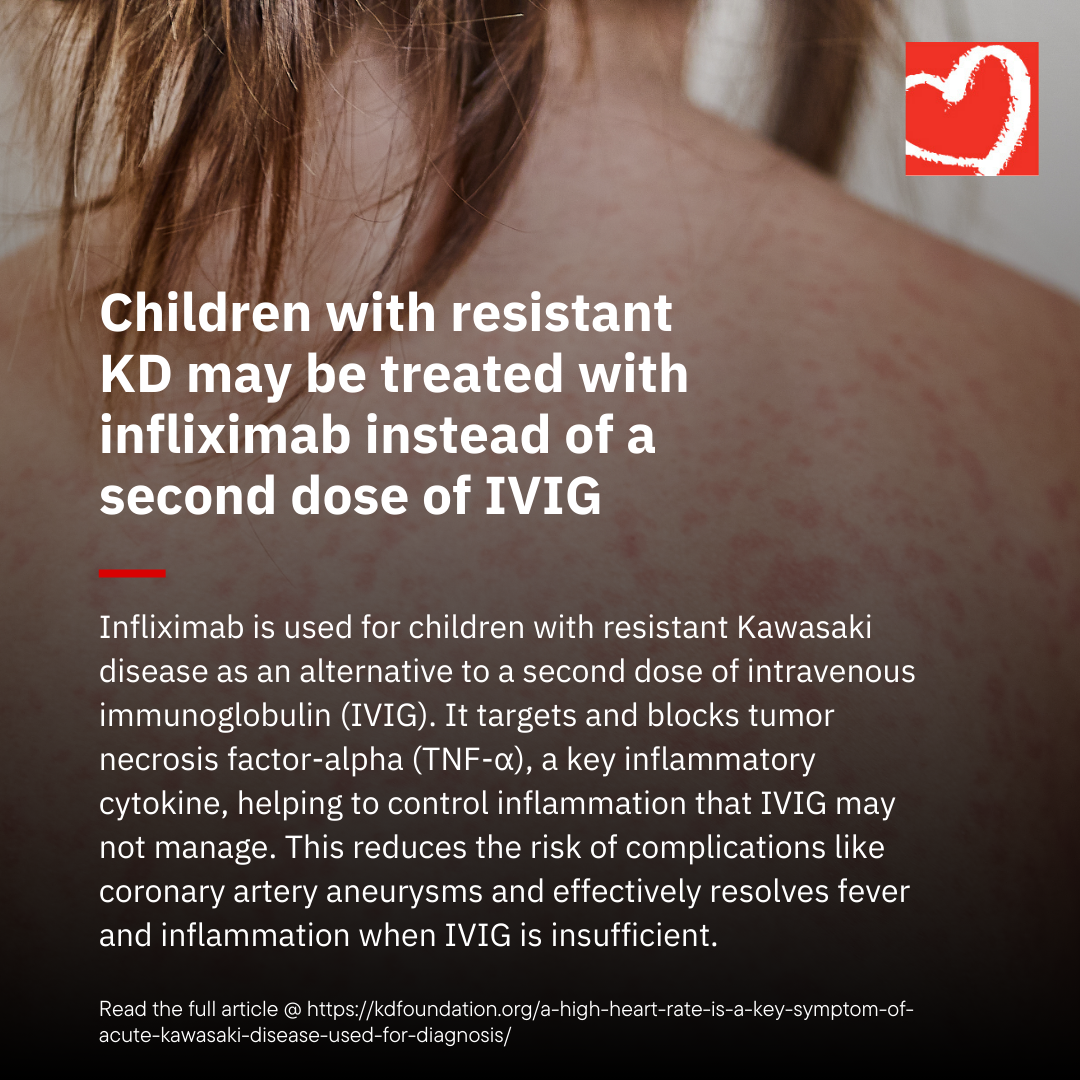
Children with resistant KD may be treated with infliximab instead of a second dose of IVIG
In the treatment of Kawasaki disease (KD), intravenous immunoglobulin (IVIG) is the standard therapy used to reduce inflammation, lower the risk of coronary artery complications, and prevent long-term heart damage. However, a subset of children with KD may fail to respond to IVIG treatment, which is known as resistant Kawasaki disease or IVIG-resistant KD. In such cases, treatment with infliximab has emerged as an alternative to a second dose of IVIG. Here’s an explanation of why infliximab is used in these cases:
1. What is Infliximab?
- Infliximab is a biologic medication that targets and blocks tumor necrosis factor-alpha (TNF-α), a cytokine involved in inflammation. TNF-α plays a key role in the inflammatory process and is elevated in conditions like Kawasaki disease.
- Infliximab is primarily used to treat autoimmune disorders like rheumatoid arthritis and inflammatory bowel disease. However, it has also been studied and used as a treatment for resistant Kawasaki disease due to its ability to modulate the immune response and reduce inflammation.
2. Why Infliximab is Used in Resistant Kawasaki Disease:
- IVIG Resistance: A certain proportion of children with Kawasaki disease do not respond to the initial dose of IVIG. This is termed IVIG-resistant KD, and these children remain at a higher risk for developing serious complications such as coronary artery aneurysms. In such cases, a second dose of IVIG is often considered, but inflammasome activation and TNF-α overproduction may be more specifically implicated in these cases of resistance, meaning infliximab might be a better therapeutic option.
- Effectiveness in Inflammation Control: IVIG works by reducing systemic inflammation and modulating immune responses, but in some patients, a persistent inflammatory response leads to the need for additional immunosuppressive treatment. Infliximab, by inhibiting TNF-α, can directly target one of the key drivers of the persistent inflammation seen in resistant KD. It helps resolve inflammation, which is essential in preventing coronary artery damage.
- Clinical Studies: Several studies have demonstrated that infliximab is effective in treating children with IVIG-resistant KD. Research has shown that infliximab leads to rapid resolution of fever and reduction of inflammatory markers like C-reactive protein (CRP) and erythrocyte sedimentation rate (ESR), making it an effective alternative when IVIG alone does not control the disease.
- Benefits Over a Second Dose of IVIG: Some studies suggest that a second dose of IVIG may not be sufficient to control inflammation in patients with resistant KD, particularly in the presence of high levels of TNF-α. Infliximab has been shown to be more effective in addressing this persistent inflammation, leading to a quicker resolution of symptoms and potentially reducing the risk of cardiovascular complications (e.g., coronary artery aneurysms). Additionally, infliximab may be preferred when a second dose of IVIG fails to work or if there are concerns about IVIG-related side effects (e.g., allergic reactions, kidney complications).
3. Evidence for Infliximab Use in Resistant Kawasaki Disease:
- A study published in the Journal of the American College of Cardiology in 2016 highlighted the use of infliximab in children with IVIG-resistant Kawasaki disease. The research found that infliximab effectively resolved the symptoms and improved inflammatory markers, making it a promising treatment option.
- A meta-analysis published in 2020 concluded that infliximab could be a safe and effective alternative to a second dose of IVIG in cases of IVIG-resistant KD. The study demonstrated that infliximab was associated with rapid defervescence (fever resolution), decreased inflammatory markers, and lower rates of coronary artery complications compared to those who received a second IVIG dose.
- According to a study in the Pediatric Infectious Disease Journal, infliximab is considered to have a favorable safety profile and is a suitable treatment option for children who do not respond to IVIG. It is often administered as a single infusion, making it a convenient alternative.
4. Current Guidelines:
- Treatment guidelines from organizations like the American Heart Association (AHA) and the Kawasaki Disease Research Center suggest infliximab as an option for patients with IVIG-resistant Kawasaki disease. Infliximab is usually given as a single dose (usually 5 mg/kg) when the child’s fever does not resolve after the first dose of IVIG.
- The decision between a second dose of IVIG or infliximab is made based on clinical factors, including the severity of the disease, the presence of complications (such as coronary artery abnormalities), and the patient’s response to the initial treatment. Infliximab may be used as a preferred option if there is significant concern about persistent inflammation and the risk of cardiovascular damage.
Conclusion:
For children with resistant Kawasaki disease, infliximab is used as an alternative to a second dose of IVIG. It works by targeting and blocking TNF-α, a key inflammatory cytokine involved in the disease’s pathogenesis. This helps control the persistent inflammation that IVIG alone cannot manage, reducing the risk of complications like coronary artery aneurysms. Infliximab has shown effectiveness in rapidly resolving fever and inflammation, making it a valuable treatment option in cases where IVIG is insufficient.
Sources:
- American Heart Association (AHA): Kawasaki Disease Guidelines. AHA
- Pediatric Infectious Disease Journal: Infliximab in IVIG-resistant Kawasaki Disease. PIDS
- Journal of the American College of Cardiology (2016): Efficacy of Infliximab in Resistant Kawasaki Disease. JACC
- Journal of Pediatrics (2020): Meta-analysis of Infliximab for IVIG-resistant Kawasaki Disease. J Pediatrics
